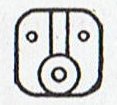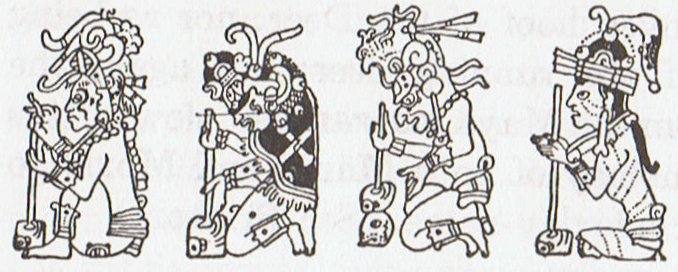An 'enclosure' (pa) could have been broken through at Hyadum I, like when a chicken is forcing himself out from his shell:

... They were Ranginui, the Sky Father, and Papatuanuku, the Earth Mother, both sealed together in a close embrace. Crushed between the weight of their bodies were their many children, whose oppression deepened. They yearned to be free; they fought their parents and each other to break loose. Tuumatauenga, virile god of war, thrust and shouted; Tangaroa of the oceans whirled and surged; Tawhirirangimaatea howled with many raging winds; Haumiatiketike and Rongomatane, of wild foods and cultivated crops tried their best but were not successful; and Ruamoko, god of earthquakes, yet to be born, struggled in the confinement of his mother's womb.
Of them all, Taane Mahuta, the god of the forests, was the most determined; he set his sturdy feet upon his father's chest, and braced his upper back and shoulders against the bosom of his mother. He pushed; and they parted. So the world; as the Maori understand it; came into being ...
| May 20 |
21 |
22 (142) |
23 |
| November 19 |
20 (324) |
21 |
22 |
 |
 |
 |
 |
| Ca3-9 |
Ca3-10 |
Ca3-11 |
Ca3-12 (63) |
| tapamea tagata kua iri |
ki te pa |
kua hua |
ki te kotiga |
| 4h (60.9) |
no star listed (61) |
Beid (62.2) Vindemiatrix |
Al Dabarān-2 |
| no star listed (60)
Cor Caroli |
HYADUM I (63.4) |
| 16h (243.5) |
ψ Scorpii (244.6), Lesath (244.8) |
χ Scorpii (245.1), Yed Prior, δ Tr. Austr. (245.5) |
Yed Posterior, Rukbalgethi Shemali (246.6). δ Apodis (246.7), ο Scorpii (246.8) |
| Acrab, Jabhat al Akrab (243.3), θ Lupi, Rutilicus (243.5), Marfik (243.7), φ Herculis (243.8) |
Possibly the central element between Kiore and Henua was Pa - the 'closed embrace':
| Kiore |
Pa |
Henua |
| the god of sky |
enclosed embrace |
the earth goddess |
Kai means to eat (etc) and vaha kai means a mouth (etc). In the glyph type we are discussing there is no eating, indeed the pa in Ca3-10 is a reversed vaha kai. I think this implies there is no 'eating' in winter. Life has stopped, come to a standstill.
In my preliminary glyph type dictionary there is a page (at pu) which in a way points to how in winter it is not possible to eat (kai). The openings signifying how life comes and goes, enters and leaves, have been 'plugged' ('killed'):
 |
 |
| pu |
puo |
|
Then he went with his father Qinggi, they say. |
|
As soon as Qinggi landed at his town, |
|
he gave a feast. |
|
He tried to make the one we speak of eat. |
|
But he would not accept a morsel. |
|
Qinggi gave a feast again the next day. |
|
to make his child eat. |
|
Again he would eat nothing. |
|
Two greedyguts arrived, |
|
and someone grabbed a storage chest of cranberries. |
|
One of the two greedyguts opened up his maw. |
|
They poured in the whole boxful. |
|
They poured one down the other's throat as well. |
|
Next day, his father gave another feast. |
|
The greedyguts arrived. |
|
Again they poured entire storage chests |
|
of cranberries into their mouths. |
|
The one we are speaking of ran to the edge of town. |
|
As he was walking there, |
|
cranberries bubbled up out of the swampland. |
|
He plugged the vent with moss. |
|
When another vent formed, he plugged it too. |
|
Then he went back to the house |
|
and asked the greedyguts closest to the door, |
|
'Tell me, how do you manage to eat so much?' |
|
'Sir, don't ask that. |
|
Do you think this is a happy way to be?' |
|
'No, but tell me. |
|
If you will eat |
|
at every feast my father gives. |
|
If you don't agree to tell me, |
|
I will plug you up for good'. |
|
'Alright, sir, sit beside me. |
|
I will tell you what to do. |
|
In the morning, take a bath and then lie down. |
|
Rub yourself raw where you feel it most deeply. |
|
By the following day, a scab will form. |
|
You must swallow the scab. |
|
He followed these instructions. |
|
Then, after sitting there awhile: |
|
'Father, I'm hungry!' |
|
His father gave a feast without delay. |
|
Again the greedyguts arrived. |
|
Again they upended boxes into their mouths. |
|
He couldn't be filled. |
|
He was famished. |
|
Qinggi gave another feast. |
|
Then he gave another and another, day after day. |
|
At last, the one we speak of went outside. |
|
When he kept picking cranberries out of their turds, |
|
they saw who it was, |
|
and they shut the door in his face. |
|
Then he walked away, they say. |
|
He went around behind his father's house. |
|
'Father, let me come in!' |
|
No answer. |
|
They turned him away |
|
|
The text above is part of the adventures of Raven ('the one we are speaking of') as told in Haida Gwaii according to 'Sharp as a Knife'. The two major openings (possible to plug) in animals and in other creatures are for input and for output:
|
... 'What's she like, Hine nui te Po?' asked Maui. 'Look over there', said Makea, pointing to the ice-cold mountains beneath the flaming clouds of sunset. 'What you see there is Hine nui, flashing where the sky meets the earth. Her body is like a woman's, but the pupils of her eyes are greenstone and her hair is kelp. Her mouth is that of a barracuda, and in the place where men enter her she has sharp teeth of obsidian and greenstone.' ... |
Holes for entering and exiting are located in the far away east respectively in the far away west. |
I also illustrated the difference between pu and its plugged variant puo:
|

|

|

|

|

|

|
|
Hb5-28 |
Hb5-29 |
Hb5-30 |
Hb5-31 |
Hb5-32 |
Hb5-33 |
|

|

|

|

|

|

|
|
Pb7-12 |
Pb7-13 |
Pb7-14 |
Pb7-15 |
Pb7-16 |
Pb7-17 |
|

|

|

|

|

|

|
|
*Qb8-11 |
*Qb8-12 |
*Qb8-13 |
*Qb8-14 |
*Qb8-15 |
*Qb8-16 |
Vaha kai could correspond to the Mayan Chikin, the Grasping Hand at the horizon in the west, an orifice which is necessary to go through for all who have been born in the east. If so, then the reversed vaha kai should represent the orifice of birth:
| ... The open right hand of Blood Moon receives the 'spittle' of the 'coco'. This 'hand' we can name Chikin, because in Maya-land that is the name for the direction west (where all sky persons will descend, fall on their faces). The horizon in the west is where Sun disappears in late afternoon. In the morning when Sun reappears in the east he is like a newborn baby, at noon he is standing tall, and in the afternoon he shrinks - he is growing old. His disappearance in the west was called 'the biting of the sun' (Chikin) by the Maya:
'The manik, with the tzab, or serpent's rattles as prefix, runs across Madrid tz. 22 , the figures in the pictures all holding the rattle; it runs across the hunting scenes of Madrid tz. 61, 62, and finally appears in all four clauses of tz. 175, the so-called 'baptism' tzolkin. It seems impossible, with all this, to avoid assigning the value of grasping or receiving. But in the final confirmation, we have the direct evidence of the signs for East and West. For the East we have the glyph Ahau-Kin, the Lord Sun, the Lord of Day; for the West we have Manik-Kin, exactly corresponding to the term Chikin, the biting or eating of the Sun, seizing it in the mouth.' (Gates, a.a.)

 
The first 4 pictures show east, north, west, and south. The lower two glyphs represent 'Lord' (Ahau) and 'grasp' (Manik). Manik was the 7th day sign of 20 such and Ahau was the last of them.
I imagine the 'Lord' was Sun and that in Likin (east) we see him (at the top formed like an inverted Ahau sign) depicted in triplicate, viz. as Morning, Noon, and Evening Sun. The 20th day sign, Ahau, will therefore be the upside down situation, with Noon Sun at the very bottom.
When Sun goes down at the horizon in the west it is a sign of the arrival of darkness. In order to 'come alive again' in the morning the day after, the fire of Sun must be rekindled. I imagine the following Maya pictures tell about the process, in which at bottom the 'grasping hand' returns the 'fire':

(Gates: Dresden tzolkin 15)
When 'rattles of serpents' (tzaab) are mentioned together with 'the biting of Sun' (Chikin), it probably is because these rattles are the dried out old remnants of the serpents. To kindle a fire you must have completely dry stuff to work with. |
|










